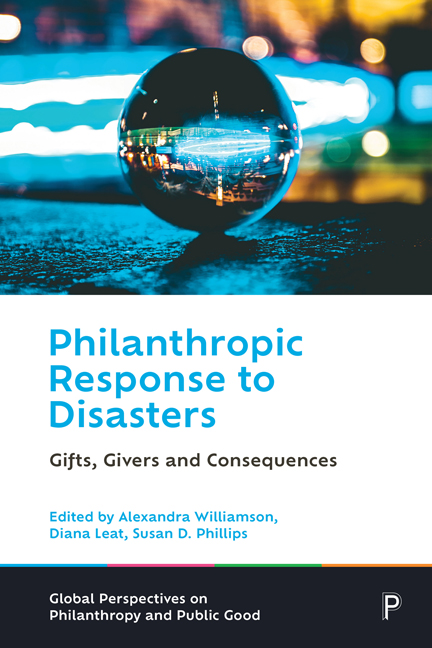Book contents
- Frontmatter
- Contents
- List of tables and figures
- Notes on contributors
- Series editors’ preface
- 1 Introduction
- 2 The public’s philanthropic response to disaster: plus ça change?
- 3 Disaster fundraising: readiness matters
- 4 Roles of philanthropic foundations as funders and distribution agents in disaster response
- 5 The private sector and disasters: from reactive response to disaster resilience
- 6 Fundraising, grantmaking and regulatory issues: regulating good in bad times
- 7 Doing good better: public policy for disaster philanthropy
- 8 Philanthropy’s place in community-based capacity development for disaster resilience
- 9 Nonprofit collaboration and coordination in disaster response: lessons from the 11 September recovery
- 10 The promise and reality of philanthropy in disasters
- 11 Conclusions and looking forward
- Index
4 - Roles of philanthropic foundations as funders and distribution agents in disaster response
Published online by Cambridge University Press: 17 January 2024
- Frontmatter
- Contents
- List of tables and figures
- Notes on contributors
- Series editors’ preface
- 1 Introduction
- 2 The public’s philanthropic response to disaster: plus ça change?
- 3 Disaster fundraising: readiness matters
- 4 Roles of philanthropic foundations as funders and distribution agents in disaster response
- 5 The private sector and disasters: from reactive response to disaster resilience
- 6 Fundraising, grantmaking and regulatory issues: regulating good in bad times
- 7 Doing good better: public policy for disaster philanthropy
- 8 Philanthropy’s place in community-based capacity development for disaster resilience
- 9 Nonprofit collaboration and coordination in disaster response: lessons from the 11 September recovery
- 10 The promise and reality of philanthropy in disasters
- 11 Conclusions and looking forward
- Index
Summary
This chapter focuses on the roles of foundations as grantmakers from their own funds, and as distribution agents for money from other sources (for example, public donations). We begin by outlining some defining characteristics of foundations, and differences between them. We then consider issues and constraints facing foundations in their response to disaster. Foundations may engage in grantmaking in a disaster but, we suggest, this is not ‘business as usual’. Roles, models, time frames and issues of geography are among the factors complicating any simple picture of foundations’ disaster responses. We explore the question of time frames, focusing on endowed foundations’ potentially special role in recovery and resilience building, and then the longer-term effects of the experience of responding to disaster on foundation thinking and practices. Finally, we offer some reflections and a plea for a more nuanced approach to describing foundations’ responses to disasters.
What are philanthropic foundations?
Both Daly (2012) and Harrow (2010) refer to philanthropy as having contested or multiple definitions, which while accurate is somewhat unhelpful. Barman (2017) and others provide perhaps the simplest definition, that of private giving for public benefit purposes, as adopted in this chapter. A definition of philanthropic foundations is influenced by multiple factors, including legal meanings, regulatory frameworks and regimes, operating principles, geographic and cultural location, the age and era of the foundation, and its purposes. We therefore focus our working understanding on those common and central elements of foundations that are central to global definitions. These concepts include independence, holding assets and distribution of income for public benefit purposes, and foundations’ supporting and intermediary roles beyond grantmaking (Williamson and Leat, 2021). Further common, but not essential concepts are those of perpetuity or forever giving, and the primary activity of grantmaking (Toepler, 1999).
The odd nature of foundations has led to some memorable characterisations. Nielsen (1972), for example, described them as giraffes in the jungle of American capitalism and democracy – they cannot possibly exist, but they do. The diversity of foundation forms encompasses both conceptual and practical classifications. At the practitioner level, foundations tend to be grouped by the size of the assets they control or by their operating context, with labels such as corporate or community foundations. Legally and conceptually, foundations may be grouped by their founders/ donor(s), organisational principles and strategic focus.
- Type
- Chapter
- Information
- Philanthropic Response to DisastersGifts, Givers and Consequences, pp. 76 - 90Publisher: Bristol University PressPrint publication year: 2023



